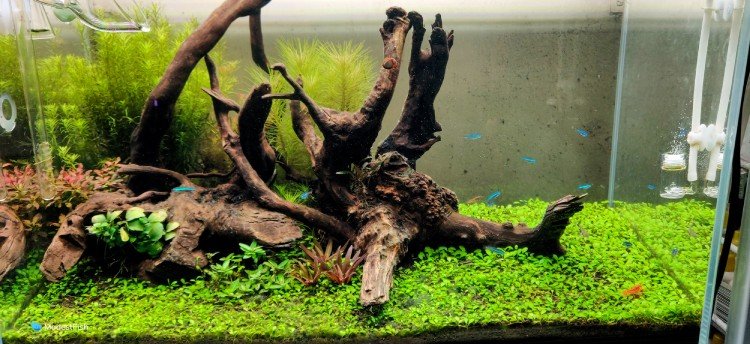Driftwood makes an awesome addition to an aquarium. It really lends itself well to any tank going for a natural look.
And the biofilm that grows on the surface of driftwood helps serve as a food source for fish like plecos, and invertebrates, like shrimp and snails.
But, just putting a piece of driftwood straight into your tank without preparing it can be a bit of a disaster.
Driftwood usually contains tannins, astringent compounds found in plants, which in excess, can dye your water brown, decrease the water’s KH and drop the pH.
Tannins aren’t dangerous, in fact, they can help reduce harmful bacterial growth. But, if you have too much in the water column all at once, your tank water can look like a glass of tea.
But, no worries, today I’ll tell you how to prepare your driftwood before you put it in the tank to reduce the amount of tannins released into your water.
And, there’s more:
Driftwood needs to be cured in saltwater before it’s placed in an aquarium. Saltwater curing will help prevent the wood from softening and rotting. Eventually, even cured wood will begin to break down, but proper curing can slow this process down tremendously.
How to Prepare Driftwood for an Aquarium

Boiling Driftwood
It’s really important to remember: boiling driftwood quickly sterilizes the piece and removes tannins, but it does nothing to cure the wood.
So, even if you boil your driftwood, I still recommend curing it in saltwater for 1-2 weeks!!
You will see many sources online that just advise boiling the driftwood and putting it straight into the tank from there, don’t be fooled!
I usually skip boiling altogether and go straight to curing with saltwater, but to each their own.
Steps:
- Place driftwood in a pot and cover it with tap water.
- Place on the stove and keep at a low boil for 1-2 hours.
- You may need to replace some of the water over time. You can also dump the water and start fresh a few times if the water turns dark brown.
- Carefully remove from heat and allow it to cool on the stovetop.
- Dump the water.
Curing Driftwood in Saltwater
Using saltwater to cure driftwood is the best method to prolong the life of the wood.
This is not a fast process, but it is worth it; be prepared to soak the wood for up to 2 weeks.
Materials:
- Patience – it might sound corny, but it’s the most important ingredient in this process.
- Bucket or water tight container big enough to accommodate the driftwood, preferably something that can handle boiling water
- Aquarium or pool salt (do not use table salt)
- Dechlorinator
- Rocks or bricks, any kind of tough heavy object you can use to weigh the wood down
Steps:
- Place the driftwood inside the container.
- Place rocks or bricks on the wood to help keep it submerged.
- Mix ½ cup of salt per gallon of hot dechlorinated water.
- Pour the water over the driftwood and leave it to soak.
- Let soak for several hours. If the water becomes darkened by tannins, dump the water and replace it with another round of hot saltwater.
- Check back on the container and dump/refill the water as needed. After a few days, the wood should begin to sink to the bottom.
- After a week, if the wood is staying submerged and is no longer leaching large amounts of tannins, dump the water, rinse the wood and place it in the aquarium. Large pieces or pieces with lots of tannins may need to be soaked for a full 2 weeks.
Final Thoughts
I know going through the full process to cure driftwood can seem like a serious pain in the butt, however, over the years, I’ve found it to be very helpful.
Fully cured driftwood lasts a whole lot longer than uncured wood.
And the hot water and salt will kill any bacteria or algae that could cause problems in a freshwater tank.
Getting excess tannins out of the wood before you put it in your display tank can prevent your aquarium from looking like a glass of iced tea.
Driftwood will likely leach small amounts of tannins over time, but nothing like it will during the curing process.
I hope you find this article helpful.
I wish you and your fish the very best!
